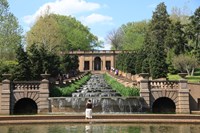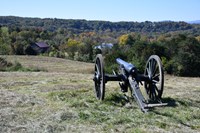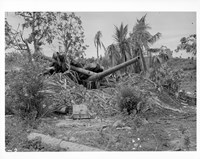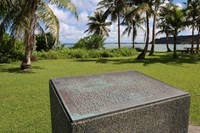- Manassas National Battlefield Park (58)
- Fredericksburg & Spotsylvania National Military Park (36)
- Antietam National Battlefield (35)
- Cedar Creek & Belle Grove National Historical Park (34)
- Petersburg National Battlefield (33)
- Boston National Historical Park (31)
- Gettysburg National Military Park (27)
- Golden Gate National Recreation Area (23)
- Charles Young Buffalo Soldiers National Monument (22)
- Show More ...
- National Historic Landmarks Program (12)
- American Battlefield Protection Program (7)
- National Register of Historic Places Program (5)
- Archeology Program (2)
- National Heritage Areas Program (2)
- Park History Program (2)
- Heartland Inventory & Monitoring Network (1)
- Mellon Humanities Postdoctoral Fellowship Program (1)
- Network to Freedom (1)
Showing 870 results for Troops ...
Road to the Sea Wayside
A Trap is Set Wayside
Bet: Freedom Seeker
Meridian Hill Park
Thoburn's Redoubt
Fonte Plateau
- Type: Place
Enlisted Barracks 1874
Pope's Creek Raid - June 11-21, 1864
Soldiers of New Jersey Monument
Asan Beach Unit
- Type: Place

In 1944, this seaside park, known locally as Assan Beach Park, was the site of fierce fighting. Assan Beach was the northern most of the two landing beaches used by American troops during the first days of the Battle of Guam. Today, the Asan Beach Unit is home to remains of the Imperial Japanese defenses and memorials to those who died during the battle.
3rd Marine Division Association Monument
Assan/Asan Beach
- Type: Place
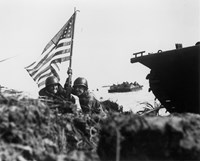
During the Japanese occupation of Guam, CHamoru were forced to build defenses on the beach, including the pillboxes and bunkers that can still be seen today, in preparation for the American invasion. That invasion came on July 21, 1944, W Day for Guam. While a simultaneous attack took place five miles south at Hågat, the Third Marine Division landed on the 2,500-yard Assan Beach, marking the start of the Battle of Guam.
William Moultrie
- Type: Person

William Moultrie's 2nd South Carolina Regiment successfully defended Charleston Harbor from the Royal Navy in the Battle of Sullivan's Island on June 28, 1776. This Patriot victory marked the beginning of a meteoric rise for Moultrie as he achieved the rank of general and later served South Carolina as governor.
- Type: Person

Banastre Tarleton, a British army officer, famously commanded the British Legion, a provincial regiment composed of loyalist infantry and dragoons, in the southern theater under Lord Cornwallis during the Revolution. Feared for his ruthlessness by the patriots, his early successes in the field earned him notoriety. Defeated at the Battle of Cowpens by Brig. Gen. Daniel Morgan, Tarleton's favor with Cornwallis declined. Tarleton was present at the surrender at Yorktown.
- Type: Person
- Type: Person

Charles Cornwallis, 1st Marquess Cornwallis and 2nd Earl Cornwallis, served as a British general during the American Revolution and notably surrendered his army to General Washington's Continental army and the allied French forces at Yorktown, Virginia in October 1781. This surrender effectively ended hostilities between British and American forces and led to peace negotiations, ending the war and recognizing American independence. Cornwallis later governed in India.
- Type: Person

Best known today for his military campaigns against the Indians before and after the Civil War, George Crook rose from the command of the 36th Ohio Infantry to the command of a cavalry division which fought in Tennessee and southwestern Virginia. During the war he became friends with future president Rutherford B. Hayes.
Piti
- Type: Place

Above the village of Piti, sit three large Japanese Vickers-type Model 3 140mm coastal defense guns, the remains of hastily constructed fortifications build on the eve of the American invasion of Guam. As the Americans conquered more and more territory in the Pacific, the Japanese forced the CHamoru to build fortifications and install artillery and costal defense guns on Guam under brutal conditions.




